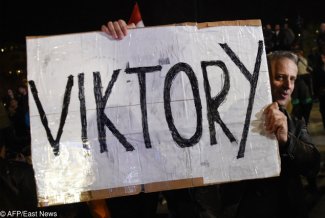Election in Hungary: Viktor Orbán’s dominance confirmed

The Fidesz-KDNP electoral coalition which has governed Hungary since 2010 achieved a sweeping victory in the parliamentary election on 8 April. According to data available after 99% votes have been counted, it gained 49% of the vote, winning 134 seats (out of 199) in the unicameral parliament. Fidesz improved its result by 4 percentage points compared to the election in 2014. It regained the two-thirds constitutional majority which it had lost in the by-elections in two single-member constituencies in 2015. Four opposition parties also made it into parliament: the nationalist Jobbik (19% support, 25 seats), the electoral coalition of the Hungarian Socialist Party and the Dialogue party (12%, 20 seats), the green party Politics Can Be Different (7%, 8 seats) and the left-wing Democratic Coalition led by the former prime minister, Ferenc Gyurcsány (6%, 9 seats). The left-wing party Together, a representative of the German minority and an independent candidate each won one seat from single-member constituencies. Voter turnout reached 67% and was the highest since 2006. The final results are expected to be announced on 14 April, after the postal votes have been counted.
It was recognised in the announcement published by the OSCE observation mission on 9 April that in technical terms the election was held in a professional and transparent manner. It was also stated that, since the government party’s resources and those of the state overlapped in all spheres, the opposition parties were unable to compete with Fidesz on equal terms.
Commentary
- Fidesz’s sweeping victory in three consecutive parliamentary elections proves this party’s dominant position on the Hungarian political scene. This is to a great extent a personal success of Viktor Orbán, who holds a firm grip on this party’s reins and who will take the post of prime minister for the fourth time (he held this position in 1998–2002 and again from 2010). In its election campaign, Fidesz almost completely reduced its message to anti-immigrant slogans. Fidesz insisted that this election was about the ‘survival of Hungary’, i.e. maintaining the cultural and ethnic homogeneity of the country and state security, linking immigration with the threat of terrorism. Orbán’s government presented itself as the defender of Hungary’s sovereignty in migration policy from foreign pressure originating from institutions of the European Union and the UN, and the influence of the US billionaire George Soros who, in the narrative presented by the party and the government, has become the personification of attempts to force Hungary to accept immigrants. Fidesz repeatedly accused the opposition of being controlled and paid by a foreign sponsor, claiming that all opposition parties are linked to Soros. Despite what was heard in Fidesz’s rhetoric, during their campaigns, none of the major opposition parties demanded the fence on the country’s southern border be liquidated.
- It was possible to make migration the central issue during the campaign because Orbán’s cabinet has for three years been engaged in a permanent anti-immigration campaign financed from public funds, and Fidesz’s election campaign was only an extension of this at the last stage. Orbán’s government regularly organised billboard and media campaigns, held so-called ‘national consultations’ several times (questionnaires with a letter from Prime Minister Orbán were sent to all citizens), and held a referendum concerning migration quotas in 2016. This was how Fidesz successfully continued the dominance of the migration issue in the public discourse, even though practically no immigrants have been seen in Hungary for more than two years as a consequence of reducing the porousness of the borders of Hungary and the Balkan states and of the agreement between the EU and Turkey.
- The key role in maintaining migration as the central issue was played by Fidesz’s dominant position in the mass media. Over the past four years, businessmen linked to Fidesz have bought, for example, all the regional dailies in Hungary and one of the two largest commercial TV stations. Hungary’s largest opposition daily was taken over by a businessman linked to the government and was wound up. The editorial staffs of the pro-governmental media – public and private alike – are conveying the same message, which seems to be coordinated by the government camp.
- Given the present arrangement on the political scene, Fidesz is benefiting from the voting system it established in 2011. The mixed voting system, with a strong majority component (106 MPs are elected in single-member constituencies during one round, and 93 are elected from party lists in the proportional system) favours the winner. Owing to this, with a 49% support, Orbán’s party gained 67% of the seats. Fidesz has a firm electorate of between 2 and 8 million of those authorised to vote, while protest votes are divided into several smaller opposition parties. This enables Fidesz to dominate in single-member constituencies where the party won 91 out of 106 seats.
- Fidesz could also count on a few additional seats due to votes cast by the Hungarian minorities in neighbouring countries. In 2011–2017, on the grounds of the simplified procedure introduced by Fidesz, Hungary gained over one million citizens, while under new voting regulations all citizens, regardless of their place of residence, can take part in elections. Even though individuals who have no registered address in Hungary can only vote for party lists (they cannot vote for candidates in single-member constituencies), the share of those who vote for Fidesz in this group exceeds 90%. 380,000 ethnic Hungarians who do not live in Hungary registered for participation in the election (in 2014, this number was 193,000). These were above all residents of Romania and Serbia, where Fidesz and local Hungarian parties loyal to Orbán were engaged in an intensive electoral campaign.
- Even though economic issues were not raised in Fidesz’s campaign, a good economic situation in the country has added to the party’s popularity. Although, according to most economic ratios, Hungary has been developing more slowly than most other EU member states from this region over the past few years, Hungary can still boast significant economic growth (4% of GDP in 2017), its unemployment rate is falling (from 11% in 2010 to 3.8% at the beginning of 2018), and the government is gradually reducing the public debt which is the highest in the region (in 2010–2017 it was reduced from 81% to 74% of GDP). The beneficiaries of Fidesz’s economic policy (including low taxes: 15% PIT and 9% CIT and tax relief for working families with children) are the middle class and entrepreneurs who form an essential part of Fidesz’s support base. A number of one-off social transfers were made in the pre-election period with the intention of winning support from less wealthy voters for Orbán’s party. The government gave all pensioners (around 2.7 million people) on two occasions purchase vouchers worth around 32 euros each. In March, it also paid a one-off heating benefit worth around 38 euros to all citizens, arguing that the winter was unusually cold.
- The election outcome worsened the crisis among the Hungarian opposition. The opposition parties were unable to force through the demands for internal reforms during the campaign. Nor did they manage to capitalise on the corruption scandals in which Fidesz was involved. The most spectacular scandal revealed during the campaign concerned the son-in-law of Prime Minister Orbán, who was accused by the EU agency OLAF of fraud in the process of obtaining EU subsidies. In Transparency International’s ranking for 2017, Hungary fell to the last but one place in the EU, ahead of Bulgaria, as regards corruption perception. The opposition media also revealed a number of cases of fortunes being amassed by politicians from the governing party and businessmen linked to it owing to clientelist and corruption mechanisms (for example, tenders, licences and companies acting as agents in foreign transactions).
- Another factor which contributed to the opposition’s electoral defeat was the inability of the opposition parties to engage in pre-election co-operation on a larger scale. Civil circles opposed to Fidesz ahead of the election encouraged Hungarians to vote tactically, i.e. to cast votes for the opposition candidate who stood the greatest chance of winning in a given constituency (for example, for left-wing candidates in Budapest or Jobbik in eastern Hungary). However, these appeals were rather unsuccessful partly because the opposition parties, with a few exceptions, were unable to agree on common candidates in single-member constituencies.
- Reactions seen among opposition circles after the election lay bare the sense of helplessness due to Fidesz’s dominance. The leaders of the largest opposition parties handed in their resignations immediately after the election. In the case of Jobbik, Gábor Vona’s resignation from the function of party president will likely mean withdrawal from the turn towards the centre he promoted and the resumption of a more radical stance. In turn, Lajos Simicska, an oligarch in conflict with the government, and a former friend of Orbán who owns most of the opposition media, announced after the election the closure of the largest conservative daily Magyar Nemzet and the intention to sell his other press titles or reduce their staff.
- Fidesz’s unquestioned victory will most likely encourage Viktor Orbán’s government to continue the political strategy involving the polarisation of public opinion and pushing through slogans of protecting Hungary from foreign influence. The Hungarian government is likely to continue operating in election campaign mode, considering the fact that more elections have been scheduled in Hungary for 2019 – to the European Parliament in spring and local elections in autumn. It may be expected that in the coming months the government will make special efforts to impede the functioning of those non-governmental organisations which are co-financed from foreign sources. A package of regulations branded in Fidesz’s campaign as ‘stop Soros’ are expected to be passed in May. These regulations will impose a number of limitations on ‘organisations supporting migration’ (including a 25% tax on foreign funding and a ban on approaching the state borders for personnel of these organisations).
- As it has gained a two-thirds parliamentary majority, Fidesz will be able to choose by itself the nominees for the top positions in the state and thus entrench its power for the next decade. The nine-year tenures of the President of the Supreme Court, the prosecutor general and the head of the central bank amongst others will expire during the government’s new term. Such a strong majority of votes also enables Fidesz to amend the constitution and adopt so-called ‘organic acts’ regulating, for example, the rules governing how the most important public institutions function. Since 2010, Orbán’s party has not officially had any written political agenda nor has it announced any specific changes to the political system. Major system changes were introduced in the first years of their rule. Therefore, possible constitutional amendments will most likely serve above all the political needs of the moment.
- As regards foreign policy, Viktor Orbán’s new cabinet will most likely continue combining the tough pro-sovereignty rhetoric and criticism of EU institutions with attempts to pragmatically build relations with western partners. Hungary will also attach a great deal of attention to maintaining correct relations with Germany and close co-operation in the Visegrad Group. Close contacts with Russia will most likely be maintained – the annual Orbán–Putin meeting will most likely take place in the coming months. Furthermore, in the EU, on the European arena, Prime Minister Orbán will continue his efforts to build up his position as a leader of conservative circles sceptical about immigration and closer European integration.




